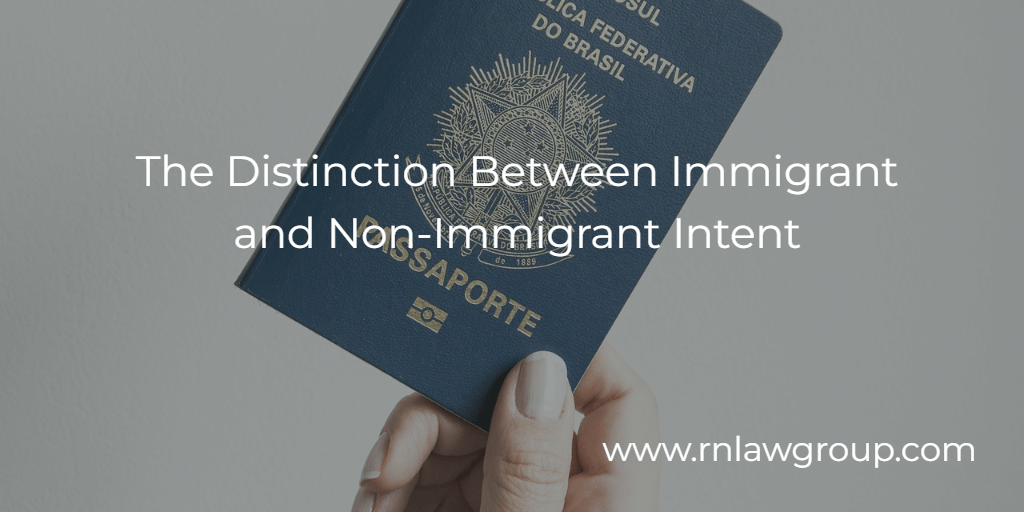
The Distinction Between Immigrant and Non-Immigrant Intent
The concepts of immigrant and non-immigrant intent play a significant role in the context of immigration law and policy. These terms define the purpose and duration of an individual’s stay in a foreign country. While both involve international travel, they represent distinct intentions and have different legal implications.
- Immigrant Intent
Immigrant intent refers to an individual’s intention to permanently relocate to the U.S. and establish permanent residency here. It is typically associated with individuals seeking to immigrate through various means, such as family-sponsored immigration, employment-based immigration, or refugee status. Immigrant intent often requires long-term plans for settlement, including finding employment, obtaining housing, and establishing ties to the community. Having immigrant intent signifies the intent to obtain permanent resident status or citizenship.
When applying for immigrant visas or permanent residency, individuals must provide substantial evidence to support their intent to live permanently in the U.S. This evidence may include documentation related to employment opportunities, familial connections, financial stability, and other factors that demonstrate their commitment to building a life in the new country they seek to call home.
- Non-immigrant Intent
Non-immigrant intent, on the other hand, refers to an individual’s intention to enter the U.S. temporarily for a specific purpose. It includes individuals who visit the U.S. for tourism, business, education, medical treatment, or cultural exchange programs, among other temporary purposes. Non-immigrant intent implies that the individual has a clear intention to return to their home country once the purpose of their visit has been fulfilled or the authorized duration of their stay has expired.
When applying for non-immigrant visas, individuals are often required to demonstrate strong ties to their home country, such as family, employment, or property that would ensure their return after the temporary stay. This is done to establish the non-immigrant’s intention to comply with the terms of their visa and to prevent potential misuse of the visa for unauthorized purposes, such as unauthorized employment or permanent settlement.
There are several U.S. visas that are primarily intended for temporary stays in the country and do not allow for dual immigrant intent. Here are a few examples:
- B-1/B-2 Visitor Visas: The B-1 visa is for individuals visiting the U.S. for business purposes, such as attending conferences or meetings. The B-2 visa is for individuals visiting for tourism, pleasure, or medical treatment. Both visas have the primary intention of temporary stay and require individuals to demonstrate strong ties to their home country to ensure their return after the authorized period of stay.
- F-1 Student Visa: The F-1 visa is for international students pursuing full-time academic studies at an accredited U.S. educational institution. The primary intent is to complete a degree program and return to the home country upon completion of studies.
- J-1 Exchange Visitor Visa: The J-1 visa is for individuals participating in approved exchange programs, including educational and cultural exchanges, internships, research programs, and more. The intent is to promote mutual understanding between the U.S. and the participant’s home country, with the expectation that the individual will return to their home country after the program ends.
- H-2B Visa: The H-2B visa allows employers in the U.S. to hire foreign workers for temporary non-agricultural jobs, typically for a specified period. The primary intent is temporary employment, and individuals are expected to return to their home country upon completion of the work contract.
- TN Visa: The TN visa is available for Canadian and Mexican citizens under the North American Free Trade Agreement (NAFTA). It allows individuals to work temporarily in specific professional occupations. The primary intent is temporary employment, and individuals must maintain ties to their home country.
These visas are generally issued for specific durations and have restrictions on activities and employment that are consistent with the temporary nature of the stay. It is important for individuals to adhere to the terms of their visa and maintain their non-immigrant intent to avoid any potential legal consequences or complications with future visa applications.
- S. Work Visas that allow for Dual Intent
There are various U.S. employment-based visas that allow for dual immigrant intent. Dual intent visas allow for individuals to have the intention to both temporarily stay in the U.S. and potentially pursue permanent residency or immigrant status. A few examples of employment-based dual intent visas include:
- H-1B Visa: The H-1B visa is a non-immigrant visa that allows U.S. employers to hire foreign workers in specialty occupations. While the primary purpose of this visa is temporary employment, individuals under the H-1B visa category may also have the intent to pursue permanent residency in the future.
- L-1 Visa: The L-1 visa is available for intra-company transferees who are being relocated to the U.S. by their employer. It allows employees of multinational companies to work temporarily in a U.S. branch, subsidiary, or affiliate. Although the primary intent is temporary employment, individuals under the L-1 visa may have the intention to transition to a permanent resident status through employment-based immigration.
- O-1 Visa: The O-1 visa is designed for individuals with extraordinary ability in the sciences, arts, education, business, or athletics. Although the visa is temporary in nature, individuals with an O-1 visa can have the intention to pursue permanent residency based on their exceptional abilities.
It is important to note that even though these visas allow for dual intent, individuals must still meet the specific eligibility criteria for each visa category and comply with the immigration laws and regulations.
- Why Intent Matters
The distinction between immigrant and non-immigrant intent holds significant legal implications. Immigration authorities scrutinize an individual’s intent to determine the appropriate visa category and assess the risk of potential visa fraud or abuse. Demonstrating a clear intent aligned with the purpose of the visa category is crucial for a successful immigration process. Failure to prove the appropriate intent can lead to visa denial, deportation, or other legal consequences.
Therefore, understanding the distinction between immigrant and non-immigrant intent is essential in navigating the complex realm of immigration. Immigrant intent indicates a desire to permanently relocate and establish residency, while non-immigrant intent implies temporary travel for a specific purpose. These intentions are reflected in visa applications, where individuals must provide supporting evidence to substantiate their claims. By recognizing the legal implications and requirements associated with each type of intent, individuals can make informed decisions and ensure compliance with immigration laws.
Reddy Neumann Brown PC, located in Houston, Texas, has been serving the business community for over 25 years and is Houston’s largest immigration law firm focused solely on U.S. Employment-based immigration. We work with both employers and their employees, helping them navigate the immigration process quickly and cost-effectively.
By : Ruth Garbanzo
Ruth Garbanzo assists clients in the beginning stages of their green card process in the Perm Labor Certification Department as well as the final stages of their green card process in the Adjustment of Status Department. Throughout our client’s green card journey, Ruth strives to provide diligent service to each client from start to finish.

